|
 he
following is a list of some of the interesting structures
that were erected for the Louisiana Purchase Exposition. he
following is a list of some of the interesting structures
that were erected for the Louisiana Purchase Exposition.
Administration Building
Fair organizers leased the new Washington  University
campus in 1901, including four buildings already built or
under construction by the University as part of their effort
to extend the Fairgrounds westward. The lease, for $650,000
ran to the end of 1903, and included provisions for payment
of another $100,000 if the fair had to be postponed to 1904.
The principal building on the campus, University Hall (today
known as Brookings Hall) became the Administration Building
for the Fair. It housed the office of President David R. Francis,
the directors, chiefs and assistants responsible for the daily
operation of the Fair, including the large press office. Other
buildings on the campus were Busch Hall, which housed the
Division of Works, Cupples Hall # 1, which housed the Anthropology
exhibits, Cupples Hall # 2 which housed the Jefferson Guard.
One dormitory building, Liggett Hall (now Prince Hall) was
under construction at the time of the lease. Funds from lease
enabled the completion of Ridgley Library (the Hall of Congresses),
Francis Gymnasium (home of the Olympics) and an additional
dormitory (later Lee, then Umrath, Hall). University
campus in 1901, including four buildings already built or
under construction by the University as part of their effort
to extend the Fairgrounds westward. The lease, for $650,000
ran to the end of 1903, and included provisions for payment
of another $100,000 if the fair had to be postponed to 1904.
The principal building on the campus, University Hall (today
known as Brookings Hall) became the Administration Building
for the Fair. It housed the office of President David R. Francis,
the directors, chiefs and assistants responsible for the daily
operation of the Fair, including the large press office. Other
buildings on the campus were Busch Hall, which housed the
Division of Works, Cupples Hall # 1, which housed the Anthropology
exhibits, Cupples Hall # 2 which housed the Jefferson Guard.
One dormitory building, Liggett Hall (now Prince Hall) was
under construction at the time of the lease. Funds from lease
enabled the completion of Ridgley Library (the Hall of Congresses),
Francis Gymnasium (home of the Olympics) and an additional
dormitory (later Lee, then Umrath, Hall).
The Palace of Agriculture
Architect: E. L. Masqueray
- Cheif of Design for the Louisiana Purchase Exposition Company,
St. Louis
Builder: Caldwell & Drake, St. Louis
 Considered
the largest building on the Fairgrounds, the Palace of Agriculture
was a testament to former President Thomas Jefferson’s
dream of an agrarian society. The building, constructed at
a cost of $525,491, stretched over twenty-three acres and
exhibited agriculture products from fifteen countries and
forty-two states. Large enough to house an entire working
dairy farm and working cider and rice mills, most fairgoers
remembered the unique sculptures made out of odd materials
such as cotton, butter, corn, salt, almonds, and cereal. These
exhibits reinforced the agricultural industries important
to the various regions of the United States. Considered
the largest building on the Fairgrounds, the Palace of Agriculture
was a testament to former President Thomas Jefferson’s
dream of an agrarian society. The building, constructed at
a cost of $525,491, stretched over twenty-three acres and
exhibited agriculture products from fifteen countries and
forty-two states. Large enough to house an entire working
dairy farm and working cider and rice mills, most fairgoers
remembered the unique sculptures made out of odd materials
such as cotton, butter, corn, salt, almonds, and cereal. These
exhibits reinforced the agricultural industries important
to the various regions of the United States.
The Palace of Education and Social Economy
Architect: Eames & Young, St.
Louis
Builder: Dunnavant & Estel, St. Louis
 Covering
eight acres on the East side of the Grand Basin, the palace
represented the idea of the Fair as an educational enterprise.
The building constructed at a cost of $365,421, contained
live displays of actual classes in session ranging from Kindergarten
to university courses. Fair goers could watch a class in progress,
attend a college course or learn the skills of calligraphy
and Braille. On the south corridor of the palace, the Department
of Social Economy’s exhibits explored pressing contemporary
questions such as housing, labor and health using statistical
tables, literature and photographs. Covering
eight acres on the East side of the Grand Basin, the palace
represented the idea of the Fair as an educational enterprise.
The building constructed at a cost of $365,421, contained
live displays of actual classes in session ranging from Kindergarten
to university courses. Fair goers could watch a class in progress,
attend a college course or learn the skills of calligraphy
and Braille. On the south corridor of the palace, the Department
of Social Economy’s exhibits explored pressing contemporary
questions such as housing, labor and health using statistical
tables, literature and photographs.
The Palace of Electricity and Machinery
Architect: Walker & Kimball, Boston
and Omaha
Builder: Goldie Construction Company, St. Louis
 In
devoting large amounts of space to machines that generated
electricity, the Fair designers wished to show that electricity
was the lifeblood of the twentieth century and gain a glimpse
of electricity’s potential—the font from which
all manner of advances would flow. Constructed at a cost of
$412,948, the building was home to the popular De Forest Wireless
Telegraph Tower. As a precursor to today’s cellular
phones, the tower allowed fairgoers to send wireless messages
to Chicago and Springfield without using a telegraph line. In
devoting large amounts of space to machines that generated
electricity, the Fair designers wished to show that electricity
was the lifeblood of the twentieth century and gain a glimpse
of electricity’s potential—the font from which
all manner of advances would flow. Constructed at a cost of
$412,948, the building was home to the popular De Forest Wireless
Telegraph Tower. As a precursor to today’s cellular
phones, the tower allowed fairgoers to send wireless messages
to Chicago and Springfield without using a telegraph line.
The Palace of Machinery
Architect: Windman, Walsh & Boisselier,
St. Louis
Builder: Smith & Eastman, St. Louis
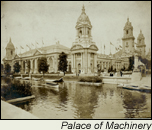 Representing
great advancements in technology, the Palace of Machinery
contained the power plant for the Exposition built by General
Electric. Covering nearly 180,000 square feet of the building,
the generator provided electricity to all the lighting, pumping
and power used to operate the concessions and exhibits. The
building constructed at a cost of $646,533, also housed exhibits
displaying the latest in tools, machinery, steam pumps and
generators. Representing
great advancements in technology, the Palace of Machinery
contained the power plant for the Exposition built by General
Electric. Covering nearly 180,000 square feet of the building,
the generator provided electricity to all the lighting, pumping
and power used to operate the concessions and exhibits. The
building constructed at a cost of $646,533, also housed exhibits
displaying the latest in tools, machinery, steam pumps and
generators.
Festival Hall, The Cascades, and Colonnade
of States
Architects: Cass Gilbert (Festival
Hall), St. Paul and New York
E. L. Masqueray (Cascades, Colonnade of States), Cheif of
Design, Louisiana Purchese Exposition Company
Builders: Strehlow & Phelps (Festival Hall)
Goldie Construction Company (Colonnade of States), St. Louis
Heman Construction Company (Cascades), St. Louis
 Festival
Hall was the crowning feature and most photographed structure
at the fair. The building, constructed at a cost of $218,430,
was the home to the world’s largest pipe organ, which
thrilled visitors with daily concerts in a 4,500 seat auditorium.
The Colonnade of States featured a monument to the thirteen
states and the “Indian Territory” that was carved
out of the Louisiana Purchase. Constructed with an additional
$59,740, the colonnade symbolically represented the success,
wisdom and foresight of the Louisiana Purchase. The Cascades
located in front of Festival Hall and the Grand Basin allowed
for forty-five thousand gallons of water a minute to flow
into the Grand Basin. As a centerpiece of the fair, the East
and West Cascades represented the Pacific and Atlantic Oceans
and symbolized man’s control over nature. Festival
Hall was the crowning feature and most photographed structure
at the fair. The building, constructed at a cost of $218,430,
was the home to the world’s largest pipe organ, which
thrilled visitors with daily concerts in a 4,500 seat auditorium.
The Colonnade of States featured a monument to the thirteen
states and the “Indian Territory” that was carved
out of the Louisiana Purchase. Constructed with an additional
$59,740, the colonnade symbolically represented the success,
wisdom and foresight of the Louisiana Purchase. The Cascades
located in front of Festival Hall and the Grand Basin allowed
for forty-five thousand gallons of water a minute to flow
into the Grand Basin. As a centerpiece of the fair, the East
and West Cascades represented the Pacific and Atlantic Oceans
and symbolized man’s control over nature.
Palace of Fine Arts
Architect: Cass Gilbert, St. Paul
and New York
Builder: Goldie Construction Company, St. Louis
 Considered
the centerpiece of Isaac Taylor’s fan-like design of
the main exposition buildings, the Fine Arts building is the
only surviving structure. Intended to be a lasting memory
of the Fair, the palace is made of steel and stone instead
of the wood and staff used in the construction of the other
buildings. During the exposition, paintings, engravings, sculptures,
jewelry, and other fine art filled this palace and demonstrated
the breadth of world art at the beginning of the twentieth
century. The building, constructed at a cost of $1,014,000,
has continued its original mission as a home for great works
of art and still serves as the location of the Saint Louis
Art Museum. Considered
the centerpiece of Isaac Taylor’s fan-like design of
the main exposition buildings, the Fine Arts building is the
only surviving structure. Intended to be a lasting memory
of the Fair, the palace is made of steel and stone instead
of the wood and staff used in the construction of the other
buildings. During the exposition, paintings, engravings, sculptures,
jewelry, and other fine art filled this palace and demonstrated
the breadth of world art at the beginning of the twentieth
century. The building, constructed at a cost of $1,014,000,
has continued its original mission as a home for great works
of art and still serves as the location of the Saint Louis
Art Museum.
Palace of Forestry, Fish, and Game
Architect: E. L. Masqueray, Chief
of Design, Louisiana Purchase Exposition Company
Builder: Kellerman Contracting Company, St. Louis
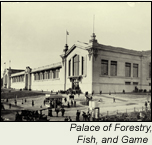 Located
just north of the Palace of Agriculture was the least elaborate
architectural palace found at the Fair. The building constructed
at a cost of $170,454, contained demonstrations being made
at the turn of the century to preserve and utilize America’s
stock of trees, fish and animals. Still displays of taxidermy
animals highlighted each state’s exhibits, but the most
popular area was the aquarium section consisting of 60 large
fish tanks, a 55 by 45 foot pool and a 40 foot diameter salt
water basin dedicated in ocean sea life. Located
just north of the Palace of Agriculture was the least elaborate
architectural palace found at the Fair. The building constructed
at a cost of $170,454, contained demonstrations being made
at the turn of the century to preserve and utilize America’s
stock of trees, fish and animals. Still displays of taxidermy
animals highlighted each state’s exhibits, but the most
popular area was the aquarium section consisting of 60 large
fish tanks, a 55 by 45 foot pool and a 40 foot diameter salt
water basin dedicated in ocean sea life.
Palace of Horticulture
Architect: E. L. Masqueray, Chief
of Design, Louisiana Purchase Exposition Company
Builder: Caldwell & Drake, Columbus, Indiana
 Located
on Agriculture Hill, the Palace of Horticulture had two distinct
and different sections. The first was an exhibit of fruits
and nuts found around the world and the second consisted of
a floral exhibit located on a 50-acre tract of land surrounding
the palaces of Agriculture and Horticulture. Constructed at
a cost of $227,338, unique features of the palace included
a basement used to provide cold storage for the fresh fruits,
and a gigantic floral map of the United States outside the
building with gravel walks marking the state lines. Located
on Agriculture Hill, the Palace of Horticulture had two distinct
and different sections. The first was an exhibit of fruits
and nuts found around the world and the second consisted of
a floral exhibit located on a 50-acre tract of land surrounding
the palaces of Agriculture and Horticulture. Constructed at
a cost of $227,338, unique features of the palace included
a basement used to provide cold storage for the fresh fruits,
and a gigantic floral map of the United States outside the
building with gravel walks marking the state lines.
Palace of Liberal Arts
Architect: Barnett, Haynes & Barnett,
St. Louis
Builder: Kellerman Contracting Company, St. Louis
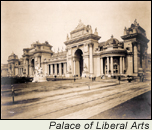 Devoted
to various exhibits classified as Liberal Arts, the building
housed displays that demonstrated how science and technology
were used to transform natural resources into manufactured
products. The building, constructed at a cost of $576,957,
housed items such as the entire Chinese collection, coins
from the British Mint, examples of German fine printing and
photographs, a model of a lighthouse, and other items from
around the world demonstrating human progress and achievement. Devoted
to various exhibits classified as Liberal Arts, the building
housed displays that demonstrated how science and technology
were used to transform natural resources into manufactured
products. The building, constructed at a cost of $576,957,
housed items such as the entire Chinese collection, coins
from the British Mint, examples of German fine printing and
photographs, a model of a lighthouse, and other items from
around the world demonstrating human progress and achievement.
Palace of Manufactures
Architect: Carrere and Hastings, New
York
Builder: John J. Dunnavant & Company, St. Louis
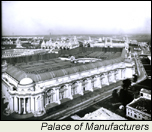 Home
to exhibits devoted to household articles, equipment, clothing,
and merchandise for personal use, many of the exhibits were
working displays where visitors could watch the creation of
clothing from companies such as Brown Shoe Company and the
Singer Sewing Company. Constructed at a cost of $723, 510,
the eastern half of the building featured displays of upholstery,
carpets and clothing considered more utilitarian than those
found in the Palace of Varied Industries. The western half
contained example of hardware such as cutlery, stoves, furnaces,
and Italian marble and alabaster statuary available for purchase
by visitors. The palace also included a bazaar where retailers
could rent six-foot square booths to sell their wares to fairgoers. Home
to exhibits devoted to household articles, equipment, clothing,
and merchandise for personal use, many of the exhibits were
working displays where visitors could watch the creation of
clothing from companies such as Brown Shoe Company and the
Singer Sewing Company. Constructed at a cost of $723, 510,
the eastern half of the building featured displays of upholstery,
carpets and clothing considered more utilitarian than those
found in the Palace of Varied Industries. The western half
contained example of hardware such as cutlery, stoves, furnaces,
and Italian marble and alabaster statuary available for purchase
by visitors. The palace also included a bazaar where retailers
could rent six-foot square booths to sell their wares to fairgoers.
Palace of Mines and Metallurgy
Architect: Theodore C. Link, St. Louis
Builder: Hill-O’Meara Construction Company, St.
Louis
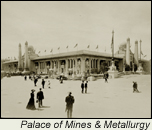 Located
on twenty-two acres, the building contained hundreds of models
of mines and exhibits of products that demonstrated the latest
in mining technology. The building constructed at a cost of
$498,661 contained examples of raw materials and the products
produced from these materials. Outside the palace, examples
of primitive mining methods by Mexican Indians, operational
displays of cement mixing, brick making, coal mining, pottery
making and a ride through a reproduction of a coal mine, gave
visitors an idea of the work needed to transform raw material
into useful products. Located
on twenty-two acres, the building contained hundreds of models
of mines and exhibits of products that demonstrated the latest
in mining technology. The building constructed at a cost of
$498,661 contained examples of raw materials and the products
produced from these materials. Outside the palace, examples
of primitive mining methods by Mexican Indians, operational
displays of cement mixing, brick making, coal mining, pottery
making and a ride through a reproduction of a coal mine, gave
visitors an idea of the work needed to transform raw material
into useful products.
Palace of Transportation
Architect: E. L. Masqueray, Chief of Design, Louisiana
Purchase Exposition Company
Builder: H. W. Schlueter, Chicago
 Designed
by Masqueray to remind visitors of a great railroad station,
the building displayed a combination of modern and historical
transportation exhibits over last hundred years. Constructed
at a cost of $684,608, the center of the building contained
a revolving steam engine to celebrate the one hundredth anniversary
of the steam locomotive. The palace also contained all types
of transportation available to the public at the turn of the
century, such as motors boats, horse cars, wagons, cable cars,
railcars, buggies, and 160 automobiles that suggested new
possibilities of travel. Designed
by Masqueray to remind visitors of a great railroad station,
the building displayed a combination of modern and historical
transportation exhibits over last hundred years. Constructed
at a cost of $684,608, the center of the building contained
a revolving steam engine to celebrate the one hundredth anniversary
of the steam locomotive. The palace also contained all types
of transportation available to the public at the turn of the
century, such as motors boats, horse cars, wagons, cable cars,
railcars, buggies, and 160 automobiles that suggested new
possibilities of travel.
U.S. Government Building
Architect: James Knox Taylor, United
States Treasury Department
 Modeled
after the Roman Pantheon, the building represented every department
of the government. Constructed at a cost of $335,000, the
building contained the Exposition’s working post office,
and housed artifacts from the Smithsonian Institute. Other
aspects emphasized the United States natural resources with
films teaching about forest preservation and the establishment
of the country’s national parks. The Government Fisheries
Building displayed both fresh and saltwater fish, the Department
of Agriculture displayed the most recent developments in the
preservation of dairy products, and the War Department set
up models of Civil War battlefields and gave live demonstrations
of the guns used in the nation’s costal defense. Modeled
after the Roman Pantheon, the building represented every department
of the government. Constructed at a cost of $335,000, the
building contained the Exposition’s working post office,
and housed artifacts from the Smithsonian Institute. Other
aspects emphasized the United States natural resources with
films teaching about forest preservation and the establishment
of the country’s national parks. The Government Fisheries
Building displayed both fresh and saltwater fish, the Department
of Agriculture displayed the most recent developments in the
preservation of dairy products, and the War Department set
up models of Civil War battlefields and gave live demonstrations
of the guns used in the nation’s costal defense.
Palace of Varied Industries
Architect: Van Brunt & Howe, Kansas
City
Builder: Rountree Construction Company, St. Louis
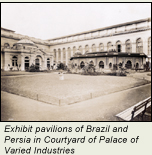 Similar
in size to the Palace of Manufactures, the Palace of Varied
Industries was the first exhibit palace built for the fair.
Used to house objects that were designed as artistically pleasing,
the palace contained objects such as art pottery, cut glass,
office and household furniture, brushes, leather articles,
jewelry, silver and goldsmith wares, clocks and watches, products
of marble, bronze, iron and upholsters’ decorations.
Constructed at a cost of $703,815 the building’s largest
exhibitors were from German and Japan who attracted fairgoers
with examples of their decorative furniture, fine pottery
and artistic products designed to showcase each countries
artistic capabilities. Similar
in size to the Palace of Manufactures, the Palace of Varied
Industries was the first exhibit palace built for the fair.
Used to house objects that were designed as artistically pleasing,
the palace contained objects such as art pottery, cut glass,
office and household furniture, brushes, leather articles,
jewelry, silver and goldsmith wares, clocks and watches, products
of marble, bronze, iron and upholsters’ decorations.
Constructed at a cost of $703,815 the building’s largest
exhibitors were from German and Japan who attracted fairgoers
with examples of their decorative furniture, fine pottery
and artistic products designed to showcase each countries
artistic capabilities.
The Pike
 Located
along Lindell Boulevard, the Pike entertained visitors with
a mile-long stretch of amusements that blended fantasy and
reality. Designed to invigorate the fairgoer’s curiosity,
visitors were entertained by thousands of performers from
thirty different nations who hoped to challenge the Victorian
values of turn of the century Americans. Entrepreneurs quickly
realized that the Pike offered a great money making opportunity
and developed attractions that included historical events,
trips to exotic locations, examples of nature’s fury,
the supernatural and a collection of carnival inspired oddities. Located
along Lindell Boulevard, the Pike entertained visitors with
a mile-long stretch of amusements that blended fantasy and
reality. Designed to invigorate the fairgoer’s curiosity,
visitors were entertained by thousands of performers from
thirty different nations who hoped to challenge the Victorian
values of turn of the century Americans. Entrepreneurs quickly
realized that the Pike offered a great money making opportunity
and developed attractions that included historical events,
trips to exotic locations, examples of nature’s fury,
the supernatural and a collection of carnival inspired oddities.
The Philippine Reservation
 The
Philippine Reservation represented the Philippine Islands,
which the United States had recently acquired six years earlier
during its war with Spain. To gain public support for America’s
foreign policy, the exhibit was designed to introduce Americans
to the country’s newest protectorate, promote the Philippines
available natural resources, and introduce Filipinos to the
benefits of American culture. Located on forty-seven acres
at the southwest corner of the Fair site, at present day Fontbonne
University, the reservation was set off from the rest of the
fairgrounds by an artificial body of water known as Arrowhead
Lake. Over one hundred buildings typical of Philippine architecture
covered the grounds, each designed to serve as a residence
for 1,100 Filipinos and give Westerners a more intimate knowledge
of the social, commercial and industrial capabilities of different
Filipino cultures. The
Philippine Reservation represented the Philippine Islands,
which the United States had recently acquired six years earlier
during its war with Spain. To gain public support for America’s
foreign policy, the exhibit was designed to introduce Americans
to the country’s newest protectorate, promote the Philippines
available natural resources, and introduce Filipinos to the
benefits of American culture. Located on forty-seven acres
at the southwest corner of the Fair site, at present day Fontbonne
University, the reservation was set off from the rest of the
fairgrounds by an artificial body of water known as Arrowhead
Lake. Over one hundred buildings typical of Philippine architecture
covered the grounds, each designed to serve as a residence
for 1,100 Filipinos and give Westerners a more intimate knowledge
of the social, commercial and industrial capabilities of different
Filipino cultures.
|
